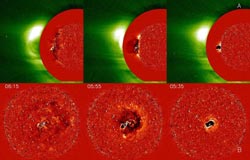Göttingen astrophysicists develop European space weather early warning system

Development of a solar storm in the corona at the left edge of the sun in the visible spectral range (A) and the connected "sun-tsunami" on the solar disc in the UV spectral range (B). The pictures from different perspectives were taken at the same time by the two satellites of NASA's STEREO mission. Source: Guiseppe Nistico, Institute for Astrophysics, University of Göttingen, and Universita della Calabria, Italy.<br>
Severe solar storms can disrupt the smooth operation of technological systems on earth, or even cause them to fail completely. Electric power outages of longer duration or disruptions of satellite navigation and communication are particularly critical in this context. In the coming years, scientists at Göttingen University are consequently aiming to develop a prototype for a European space weather early warning system.
Specifically, the early warning system is intended to safeguard the operation of telecommunication and navigation systems on earth. Under the direction of the Göttingen astrophysicist Dr. Volker Bothmer, institutions and enterprises in Germany, Belgium, Norway, the Ukraine and the USA are collaborating. The European Union is granting almost two million euros in support of the project. The entire project funding amounts to more than 2.5 million euros.
Solar storms are a consequence of extremely rapid gas eruptions in the sun’s atmosphere, at speeds of up to ten million kilometres per hour. Within one day these storms can cover the approximately 150 million kilometers to reach the earth, where they become visible in the form of polar lights, for example. The scientists are predicting maximum levels of sun activity for 2012 and 2013. In order to develop an early warning system by that time, they are analysing space weather data from space missions currently in operation: NASA’s STEREO, SDO and ACE missions, ESA’s mission Proba 2, and the international space station ISS. Using model calculations and computer simulations, they aim to forecast the arrival of severe solar storms and their expected impact with the highest possible degree of reliability, so that measures to secure the technology at risk in Europe can be implemented in time. This work is being carried out using high temporal resolution 3D mapping of the distribution of electron density in the earth’s upper atmosphere which the University of Göttingen together with the German Aerospace Centre will be making available online.
In addition to the University of Göttingen, partners in the project “Advanced Forecast For Ensuring Communications Through Space (AFFECTS)” are the German Aerospace Centre in Neustrelitz, the Fraunhofer Institute for Physical Measurement Techniques in Freiburg, the firm Astrium ST in Friedrichshafen, the Planetarium Hamburg, the Royal Observatory of Belgium in Brussels, the Institute of Geophysics of the University of Tromsø in Norway, the Ukrainian Space Research Institute, and the Space Weather Prediction Center of the USA National Oceanic and Atmospheric Administration. The administrative project management will be carried out by the EU Office at the University of Göttingen in cooperation with the project director.
Contact:
Dr. Volker Bothmer
Georg-August-Universität Göttingen
Fakultät für Physik – lnstitut für Astrophysik
Friedrich-Hund-Platz 1, 37077 Göttingen, Germany
Tel.: +49 (0)551 39-5044, Fax: +49 (0)551 39-5043
Email: bothmer@astro.physik.uni-goettingen.de
Media Contact
All latest news from the category: Physics and Astronomy
This area deals with the fundamental laws and building blocks of nature and how they interact, the properties and the behavior of matter, and research into space and time and their structures.
innovations-report provides in-depth reports and articles on subjects such as astrophysics, laser technologies, nuclear, quantum, particle and solid-state physics, nanotechnologies, planetary research and findings (Mars, Venus) and developments related to the Hubble Telescope.
Newest articles

Silicon Carbide Innovation Alliance to drive industrial-scale semiconductor work
Known for its ability to withstand extreme environments and high voltages, silicon carbide (SiC) is a semiconducting material made up of silicon and carbon atoms arranged into crystals that is…

New SPECT/CT technique shows impressive biomarker identification
…offers increased access for prostate cancer patients. A novel SPECT/CT acquisition method can accurately detect radiopharmaceutical biodistribution in a convenient manner for prostate cancer patients, opening the door for more…

How 3D printers can give robots a soft touch
Soft skin coverings and touch sensors have emerged as a promising feature for robots that are both safer and more intuitive for human interaction, but they are expensive and difficult…





















